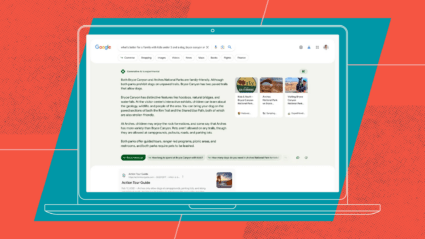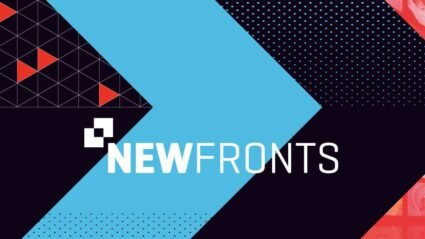Pandemics, elections, calls for social change: all of these things are affecting the world as we speak, and that includes your digital marketing strategy. But that constant beat of change can make it difficult to take a minute and think about the future. The big picture. Where we’re all going.
That’s when we call Nicolas Darveau-Garneau, Google’s Chief Evangelist.
We got the opportunity to sit down with NDG (yes, his job is cool enough that he can go by his initials) to take a look at his vision for the future of marketing—and what you need to do to be ready for it.
WATCH NOW
NDG identified three major components that will affect the marketing of tomorrow you should be focusing on to make a difference right now:
- Performance marketing
- Performance branding
- Customer experience
To get there, you also need to make sure you’re applying the secret sauce of a great marketing team culture that’s built for agility and driven by data.
“The change that we’re starting to see now is going to be really dramatic. And companies who really embrace that change will see some really extraordinary results.”
Let’s start by uncovering the crystal ball and taking a look at NDG’s marketing forecast.
Embrace the Machine: The Future of Digital Marketing Is Automated
The biggest prediction NDG threw down is a big one: 100% of advertising will be digital and automated by 2025.
If you find that number startling, consider that 55% of advertising in the US is online right now, and the current pandemic is only serving to accelerate the trend toward digital channels.
But there’s a reason CEOs and CMOs might be less surprised than you might think by that prediction when you start taking it apart: NDG posited that 65-75% of that advertising will be online ads, but around 35% will be traditional advertising like television ads or billboards. The difference will be that all of that purchasing will be done online and automated like digital ads.
“We’re spending so much time today than in the past optimizing media, picking the right keywords, putting the right targeting on banners, and so forth, but that will be more and more automated and machines will help us do that more and more,” says Darveau-Garneau.
So if a large chunk of marketing is pitting machine learning v. machine learning, how do you win? That’s where the human factor comes into play, through three key ingredients to a successful marketing strategy of the future.
Performance Marketing: The Road to Infinite Marketing Spend
NDG pointed out that marketers who aren’t thinking big enough focus too much on efficiency metrics instead of profits. The goal of performance marketing should be to make sure you’re getting every ounce of profit from your efforts.
So how do you make that change?
- Focus on the right KPIs. Many marketers make the mistake of trying to maximize ROI, but that’s not actually the same thing as focusing on profit. Uncapping budgets and upping cash flows allow you to rapidly scale the highest performing channels and ultimately increase profitability for your business. Start by building out a dashboard that motivates your marketing teams to make as much money as possible from your marketing channels instead of prioritizing efficient spend and return.
- Test your ROAS. Don’t fall in love with a target ROAS: instead, move it around until you find the right ROAS that gives you the best results and the best bang for your buck. Once you have that number, you can make the case for the budget that covers full demand, which means the case for an infinite marketing budget as long as you are hitting the target ROAS. Try testing that infinite marketing budget strategy in less saturated markets to prove to yourself and your finance team that you deserve a bigger budget across the board if you want to avoid getting left behind by the competition. “Do it slowly, judiciously, but you should try to transition to an infinite marketing budget as quickly as possible.”
- Share margin data with Google. You can make a lot more money if you have Google on your side sifting through margin data, not just revenue data. “If one of your $100 transactions made you $80 a margin, and another one made you $20 a margin, and if the machine learning algorithm knew that, it would behave quite differently and make you a lot more money. If you’re concerned by the way of sharing margin data with the Google machine learning algorithm, you can just index it. So that data is not shared, we just have a relative sense of the value of each transaction,” says Darveau-Garneau.
- Focus on Customer Lifetime Value. To actually get the full value out of automation, you need to prioritize groups of customers by lifetime value. When we talk about profitability, we’re not just looking at short-term profits, we’re looking at the long-term profitability of your business. If you haven’t started thinking about customer lifetime value and segmenting your advertising to target the highest value customers, you need to start right now. That doesn’t mean you have to get everything perfect: even forecasting out to quintiles or deciles will get you on the right path. Focus on those top 20% existing customers, and try to find more people like that.
- Build a holistic measurement strategy. One major reason marketers fail to make the case about upper funnel marketing investment is because they’re measuring channels on their own and not taking the full funnel into account. If you’re measuring YouTube, for example, on a last click basis, it’s not going to look very effective, because customers don’t tend to buy immediately after seeing a YouTube ad. To understand how the channel or an ad is performing, you need to understand and track its impact on the funnel as a whole. If you’re just measuring each part individually without looking at the total customer journey, you’re likely to over-invest in lower funnel advertising.
- Invest in creative that performs. We tend to spend a lot of money on brand marketing creative, but it’s an extremely important element in successful performance creative as well. Creative should highlight how your product or service is useful to your customer, and you can use data to make decisions and personalize advertisements so they are as helpful and targeted as possible. It is a crucial investment when it comes to the success of your ad campaigns. Your team can start by gathering examples of effective creative that have convinced them to make a purchase or research a new product.
“There are two telltale signs of great performance advertisers: they have an infinite marketing budget, and they’re trying to make as much money as possible, not maximizing ROAS.”
Performance marketing is necessary to succeed in the marketing world of the future—but it’s not enough. You also need to build a powerful brand to support those efforts.
Performance Branding: The Value of Building a Powerful Brand
Marketing could be defined as the tension between traditional brand marketing and results-focused performance marketing. But NDG is a performance marketer who was converted into a brand believer and emphasized the importance of brand building in tandem with performance marketing.
All of that advertising you’re doing needs to be backed up by a powerful brand to maximize the lifetime value of your customers. The difficulties around measuring the impact of brand marketing can be uncomfortable for performance marketers, but that doesn’t mean it’s not worth doing. It just means you have to think a little differently about your efforts and put in a little more legwork on the brand marketing side by investing in a strategy called performance branding.
“An extraordinary amount of value is created by building a brand: by people going directly to your site, or searching for your brand on Google, or converting at a higher price, or driving a higher lifetime value. But the most important thing when you’re building a brand is understanding the value and really believing in it.”
Here’s NDG’s tips on how to transform your marketing strategy by building out performance branding:
- Move up the funnel slowly. Start by investing in lower funnel, short-term ROI positive ads on a channel like YouTube. Measure your performance, and, once you’ve nailed it, move up the funnel a little bit and start running consideration ads on YouTube. As soon as you’ve mastered that, start building awareness through YouTube ads.
- Start in a specific area. Much of the distress around brand marketing investment comes from attribution and measurement challenges associated with longer lead times. So start small: pick a single state or small region and build up the funnel as described in Step 1. Once you’ve gotten all the way to the top, you’ll be able to see the effect with the naked eye without a hardcore attribution model.
- Create short-term metrics. It’s important to note that you need to have realistic expectations and realize that building a brand takes time. Try to find short-term metrics, like Google’s cost-per-lifted-user, that project what the long-term metrics are going to look like.
- Scale your efforts. When you can see that your efforts are making an impact in that particular area, which helps these tests remain relatively inexpensive, you can scale your performance branding strategy to the whole country and even the world.
“Brand marketing is now becoming a lot more like performance marketing: you can now optimize in real time and hold it accountable, but you need to give it time to work.”
So your marketing is performing and your brand is lifting… and none of it matters if your customers arrive on your site or your storefront or the purchase point and have a terrible experience.
That’s why NDG emphasized that the final crucial element of a great marketing strategy is…
Customer Experience
Your marketing efforts will only take you so far if your company falls down on customer experience. The most perfect performance marketing campaign won’t get you very far if your website is a hot mess.
NDG shared his tips on making sure your business is providing a satisfactory customer experience:
- Optimize your site for mobile. Many of your consumers are on their phones. If your site isn’t fit for the small screen, you’re going to lose out on a lot of opportunities. Make sure your site renders flawlessly on mobile, and don’t forget to check your mobile site speed.
- Remove sources of friction. If customers know your business will make them feel taken care of, and that dealing with your business is easy and pain-free, that customer is going to come back again and again.
“It’s actually amazing how this pandemic has sorted companies into two groups: companies who were able to deal with it because they already had a relatively low-friction experience and companies who had a really high-friction experience and couldn’t deal with the changes.”
- Make it personal. Make your customers feel seen and position your brand to be as useful as possible to them. This doesn’t have to be the creepy version: try A/B testing landing pages to see which one converts better for your top-performing customers. You might discover that a certain landing page is great for a certain customer group, but another page is much better for a second group: that’s the first step to conquering personalization.







Responses